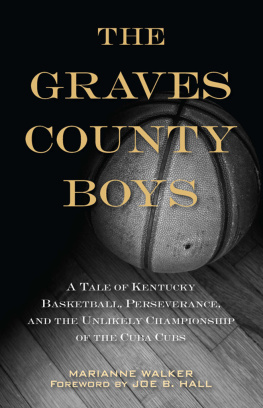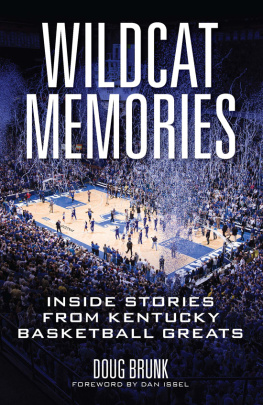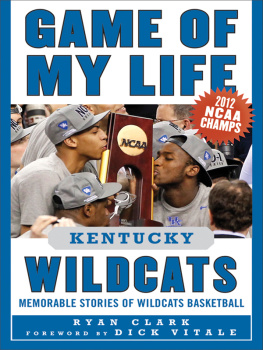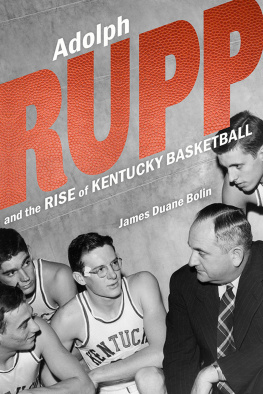The Graves County Boys
THE GRAVES COUNTY BOYS
A TALE OF KENTUCKY BASKETBALL, PERSEVERANCE, AND THE UNLIKELY CHAMPIONSHIP OF THE CUBA CUBS
MARIANNE WALKER
FOREWORD BY JOE B. HALL

Copyright 2013 by Marianne Walker
Published by the University Press of Kentucky,
Scholarly publisher for the Commonwealth, serving Bellarmine University, Berea College, Centre College of Kentucky, Eastern Kentucky University, The Filson Historical Society, Georgetown College, Kentucky Historical Society, Kentucky State University, Morehead State University, Murray State University, Northern Kentucky University, Transylvania University, University of Kentucky, University of Louisville, and Western Kentucky University.
All rights reserved.
Editorial and Sales Offices: The University Press of Kentucky 663 South Limestone Street, Lexington, Kentucky 40508-4008
www.kentuckypress.com
17 16 15 14 13 5 4 3 2 1
Library of Congress Cataloging-in-Publication Data
Walker, Marianne, 1933
The Graves County boys : a tale of Kentucky basketball, perseverance, and the unlikely championship of the Cuba Cubs / Marianne Walker ; foreword by Joe B. Hall.
pages cm
Includes bibliographical references and index.
Previously titled: When Cuba conquered Kentucky, 1999.
Originally published: Nashville, TN : Rutledge Hill Press, 1999.
ISBN 978-0-8131-4305-7 (pbk. : alk. paper) ISBN 978-0-8131-4418-4 (epub)
ISBN 978-0-8131-4419-1 (pdf )
1. Cuba Cubs (Basketball team)History. 2. BasketballKentuckyHistory. 3. School sportsKentuckyHistory. I. Title.
GV885.42.C83W34 2013
796.323630976993dc23
2013023503
This book is printed on acid-free paper meeting the requirements of the American National Standard for Permanence in Paper for Printed Library Materials.

Manufactured in the United States of America.

Member of the Association of American University Presses
For Ulvester Walker
and in memory of my parents,
Joseph D. and Rose Spatafora-Cascio
Always bear in mind that your own resolution to succeed is more important than any other thing.
Abraham Lincoln, November 8, 1856,
in a letter to Isham Reavis,
an aspiring law student
Contents
Foreword
The Graves County Boys is a great story from start to finish. It is about a small group of teenagers coming of age in a remote region of Kentucky, where values were passed down from one generation to another. Marianne Walker tells the boys story so engagingly that this book will appeal to a wide range of readers: of all ages, and whether they are fans of basketball or not. It is a true story about life during the 1940s and early 1950s and about the achievement of dreams. These boys, called the Cuba Cubs, were taught by their young coach, Jack Story, how to make the best use of their individual athletic strengths. Even more important, the coach convinced them they could do something great, something that had never been done before in their area. He taught them not only to dream about success, but how to make their dream come true.
I got caught up in reading this book not only because I love basketball and coached the sport for many years, but also because I have long been interested in this Cuba Cubs team. When the Cubs won the state basketball championship in 1952, I was working and could not get away to see the tournament games. But I had heard how exciting the Cubs were that year and how the team, from the tiny community of Cuba, Kentucky, had captured the hearts of basketball fans from all over.
After I was hired by the University of Kentucky as an assis tant to Coach Adolph Rupp and moved back to Lexington in 1965, one of the first things I did was go to the university archives and check out the film of the Cuba Cubs championship game. Having joined the Harlem Globetrotters in 1951 for a European tour, I was intrigued by the way the Cubs imitated the style of some of the Globetrotters. I thought it was great that those kids could perform many of the Trotters feats so astonishingly well.
However, it was not until I read this book that I had a full appreciation of the extent of what they did. Marianne does not merely describe their games, she also delves into their childhoods and traces the development of their lives, spent in an isolated rural region where indoor plumbing and electricity were not available in all of their homes as late as 1952.
I appreciate what those boys did so much more after reading Mariannes in-depth study of their lives and hardships. Marianne describes the place where the Cubs were born and raised; she tells about their parents and their struggles to eke out a living during the Depression in the 1930s. She also describes their neighbors, the coach, and the school with such immediacy that I felt as if I knew them all and was right there in Graves County with them. She shows how the school, in those days, was the center of community life and how the entire community supported the school and its basketball team.
This book is a lesson in life. It highlights the importance of dedication and determination, both of which require hours and hours of hard work in order to master certain techniques and to develop individual strengths. From all that effort the Cubs made came a confidence that was built on solid ground.
This book is so much more than a story of a basketball season. It is about a dream that some boys and a coach made real for themselves and for an entire community.
The Graves County Boys is so well written that you will find yourself enjoying the entire trip, not just the tournament games. This story is compelling from the first bounce of the ball to the lifting of the trophy.
Coach Joe B. Hall
Preface
The idea for this book came from my friend Pam Thomas who, years ago, suggested I write an article about her husbands high school basketball team. Puzzled, I shook my head no, reminding her that I did not do sports. At that time, Pam was married to Howard Crittenden, who was principal of the large high school in Henderson, Kentucky, where I live. She explained that he had been a star player on his high school team, the Cuba Cubs, in Cuba, Kentucky. His team lost the state championship as juniors but won as seniors in 1952. The players were so good, she boasted, at imitating the Harlem Globetrotters that they drew large crowds to all their games and the manager of the Trotters invited them to St. Louis to attend one of their games in 1951. She wanted me to talk to Howard and some of his teammates, saying she thought I would find some good material to write about.
I was doubtful. Happily immersed in research for a biography I was writing of Margaret Mitchell, author of Gone With the Wind, and her Kentucky husband, John Marsh, I was not interested in a basketball story. Only as a courtesy to Pam did I listen to her husband talk about his experiences one evening. We met again later when his childhood friend, the other star player on the team, Charles Floyd, nicknamed Doodle, came from Knoxville, Tennessee, to visit him and Pam. But the more they talked about games, strategies, opponents, and their coach, the more convinced I was that this topic was not for me.
I began to change my mind on the summer day my husband and I went with Howard and Doodle to Graves County, Kentucky, to visit their hometowns of Cuba and Pilot Oak. Actually, neither of these places was ever a town; they were tiny farming communities with a few houses, a store, a school, a blacksmith, and a couple of churches. Both are far less populated now than they were when Howard and Doodle were growing up. In those days they were thriving communities. Now they are mostly wide fields and forests. Howard and Doodle gave us a tour of all the locations that were significant in their childhoods. We saw where their homes had once stood in the woods at the end of dirt roads, where their tobacco patches and pastures had been, the locations of their schoolhouse and the pounded-dirt half-court in front of the Pilot Oak Store where they first learned to play basketball. They talked about how their friendship began when they were young children and how much Coach Jack Story had done for them.
Next page









